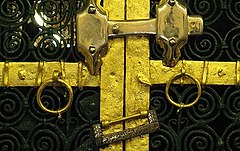 The door of Fatima's house (the actual 1400 years old door didn’t look like this) | |
| Native name | حادثة كسر الضلع (lit. 'accident of rib fracture') |
|---|---|
| Date | 632 CE |
| Location | Fatima's house, Medina |
| Target | Ali's pledge of allegiance |
| Deaths | Muhsin bin Ali, Fatima |
| Part of a series on |
| Islam |
|---|
 |
The attack on Fatima's house refers to a disputed violent attack on the house of Fatima, daughter of the Islamic prophet Muhammad.[1] The attack is said to have taken place shortly after the death of Muhammad in 11 AH (632 CE) and was instigated by his successor Abu Bakr and led by Umar, another companion.[1][2][3] The purpose of the attack was to arrest Fatima's husband Ali, who had withheld his pledge of allegiance to Abu Bakr.[2][3][1] Her injuries during the raid might have caused the young Fatima's miscarriage and death within six months of Muhammad.[2][3]
The above claims are brought forward by the Shia and categorically rejected by the Sunni, the two largest branches of Islam.[4][1] On the one hand, Shia historians list some early Sunni sources that corroborate these allegations,[5] arguing that sensitive information about the incident has also been censored by Sunni scholars who were concerned with the righteous presentation of companions.[6] On the other hand, it is unimaginable for Sunnis that the companions would engage in violence against Muhammad's family.[4] In turn, Sunni Islam holds that Fatima died from grief after the death of Muhammad and that her child died in infancy of natural causes.[7][1][4] Following her will, Abu Bakr was excluded from the private funeral of Fatima,[8][8] and she was buried secretly at night.[9][1] Fatima has been compared to Mary, the mother of Jesus, especially in Shia Islam.[10][11] In view of Fatima's place in Islam, these allegations are highly controversial, with beliefs primarily split along sectarian lines between Sunni and Shia denominations.
- ^ a b c d e f Fedele 2018.
- ^ a b c Khetia 2013, p. 77.
- ^ a b c Buehler 2014, p. 186.
- ^ a b c Abbas 2021, p. 98.
- ^ Abbas 2021, pp. 97–8.
- ^ Khetia 2013, p. 39.
- ^ Veccia Vaglieri 2022a.
- ^ a b Mavani 2013, p. 117.
- ^ Khetia 2013, p. 82.
- ^ Fedele 2018, p. 56.
- ^ Ernst 2003, p. 171.